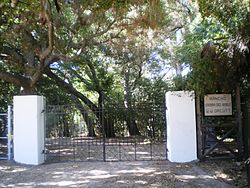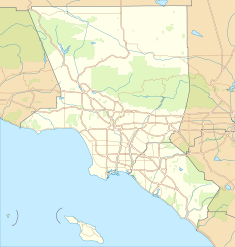- Orcutt Ranch Horticulture Center
-
Orcutt Ranch Horticulture Center L.A. Historic-Cultural Monument #31 Orcutt Ranch gate, September 2008Location: 23555 Justice Street, West Hills, Los Angeles, California, USA Coordinates: 34°13′07″N 118°38′26″W / 34.21861°N 118.64056°W Area: 210-acre (0.85 km2) Built/Founded: 1903 Architectural style(s): Spanish Colonial Revival Style Designated as LAHCM: 2 November 1962[1] Governing body: City of Los Angeles Dept. of Recreation and Parks The Orcutt Ranch Horticulture Center, formally known as Rancho Sombra del Roble, is a Los Angeles Historic-Cultural Monument (HCM #31) located in the West Hills section of Los Angeles, California, USA.
Contents
William Orcutt's vacation home
Orcutt Ranch was the vacation and retirement estate of William Warren Orcutt, an early pioneer of oil production in California and the discoverer of one of the first prehistoric skeletons at the La Brea Tar Pits.[2][3] The Rancho Sombra del Roble, Spanish for "Ranch of the Shaded Oak", was originally a 210-acre (0.85 km2) cattle ranch and citrus orchard at the foot of the Simi Hills.[4] Orcutt bought the property in 1917,[5] and hired architect, L.G. Knipe (who designed some of the original campus structures of Arizona State University) to design his home on the ranch. The 3,060-square-foot (284 m2) residence, in the blend of Spanish Colonial Revival Style and Mission Revival Style architecture, was completed in approximately 1926. It features glazed tiles from Mexico and carved mahogany and walnut from the Philippines.[6] Visitors are surprised to find that the design of the home prominently incorporates bas-relief Swastika architectural decoration.[5] Mary Orcutt, William's wife, chose the symbol due to its connection with Native American traditions, and did so before the Nazis turned it into a symbol of anti-semitism and genocide.[5] President Herbert Hoover, who was a friend of the Orcutt's, visited the ranch.[6]
Acquisition and operation by the City
A 24-acre (10 ha) portion of the original estate, including the residence, gardens, oaks and citrus orchard, was designated as a Historic-Cultural Monument in January 1965. Those 24 acres (10 ha) were purchased by the City of Los Angeles in 1966 for $400,000.[5] The 24-acre (10 ha) city-owned property includes a Spanish-style adobe residence, extensive gardens, oak trees hundreds of years old, Dayton Creek, nature trails, fruit orchards, rose gardens, community garden plots, picnic tables and a multitude of exotic trees, plants and shrubs.[5] Some of the more unusual trees found at the ranch are Purple Lily Magnolias, Lady Palms ( Raphis excelsus ) native to Asia, Bunya Bunyas ( Araucaria bidwillii ) evergreen native to Australia with cones weighing up to 15 pounds (7 kg)), Cork Oaks ( Quercus suber ), and one of the many Coast Live Oaks ( Quercus agrifolia ) measuring 32 feet (10 m) in circumference, believed to be 700 years old.[2][3][6][7] For 53 years (1927–1980), Ernest Conrejo was employed as the property's caretaker and gardener. Cornejo was hired at age 17 to plant and tend to the exotic trees and plants; he continued in that job until he was ousted at age 70 from his lifetime home by the city.[8]
The Los Angeles Recreation and Parks Department operates Orcutt Ranch,[9] which is available to be rented for special events. It is also opened up for popular public fruit picks.[7][10][11][12]
See also
- Citrus
- Orange (fruit)
- Citrus production
- California Citrus State Historic Park
- Agricultural Museum (periodical)
- List of Los Angeles Historic-Cultural Monuments in the San Fernando Valley
- Mission Revival Style architecture
- Spanish Colonial Revival architecture
References
- ^ Los Angeles Department of City Planning (September 7, 2007) (PDF). Historic-Cultural Monuments (HCM) Listing: City Declared Monuments. City of Los Angeles. http://www.cityprojectca.org/ourwork/documents/HCMDatabase090707.pdf. Retrieved 2008-05-29
- ^ a b Doug Smith (1975-12-25). "Groups to Conduct Tours of Orcutt Ranch Center". Los Angeles Times.
- ^ a b William S. Murphy (1982-11-25). "Valley Digest; Places to Go Orcutt Site Keeps '20s in Bloom". Los Angeles Times.
- ^ Judson Grenier (Editor-in-chief) (1978). A Guide to Historic Places in Los Angeles County, p. 102. Kendall/Hunt Publishing Co.. ISBN 0840375018.
- ^ a b c d e Gary Klein (1993-12-31). "The Land Progress Forgot: William Orcutt's vacation home is now owned by Los Angeles, but it still is a good place to get away from it all". Los Angeles Times.
- ^ a b c Ira Gribin (1981-09-13). "Gardens, artifacts at Orcutt Ranch in Canoga Park; ORCUTT RANCH CENTER". Los Angeles Times.
- ^ a b Roselle M. Lewis (1987-08-01). "$1 a Bag, $2 a Box for Citrus You Pluck at Orcutt Ranch". Los Angeles Times.
- ^ Martha L. Willman (1980-05-11). "Caretaker Loses 'Lifetime' Home; Caretaker Loses 'Lifetime' Home at Orcutt Ranch Park". Los Angeles Times.
- ^ la parks
- ^ "Hundreds Turn Out to Pick Citrus; Plenty Is Left". Los Angeles Times. 1983-07-21.
- ^ Miguel Bustillo (1999-08-20). "Valley Roundup: West Hills; Fruit Pick Planned Saturday at Orcutt Ranch". Los Angeles Times.
- ^ Sarah Torribio-Bond (2000-07-08). "Valley Roundup: West Hills; Annual 'Fruit Pick' to Begin Today". Los Angeles Times.
External links
- Official Orcutt Ranch Horticulture Center website
- CSUN Library Digital Archives: San Fernando Valley Citrus Fruit Industry collection - online vintage photographs.
Revival styles in Western architecture and decorative arts International Baroque Revival · Beaux-Arts · Neo-Byzantine · Carpenter Gothic · Châteauesque · Egyptian Revival · Gothic Revival · Greek Revival / Neo-Grec · Moorish Revival · Neoclassical · Renaissance Revival / Italianate · Romanesque Revival · Second EmpireBritish Empire Bristol Byzantine · Edwardian Baroque · Indo-Saracenic Revival · Jacobethan · Queen Anne Style · Scots Baronial Style · Tudor RevivalFrance Germany Greece Portugal Russian Empire and USSR Scandinavia Spain United States Jeffersonian architecture · American Renaissance · Colonial Revival · Mayan Revival · Mediterranean Revival · Mission Revival · Pueblo Revival · Queen Anne Style · Richardsonian Romanesque · Spanish Colonial Revival · Territorial RevivalHistory of California to 1899 Precontact · First explorations · Later explorations · Spanish colonization · Russian colonization · Mexican rule · California Trail · Mexican-American War · U.S. rule · Gold Rush · Civil War
since 1900 By topic By city Los Angeles · Riverside · Sacramento · San Bernardino · San Diego · San Francisco · San Jose
U.S. National Register of Historic Places Topics Lists by states Alabama • Alaska • Arizona • Arkansas • California • Colorado • Connecticut • Delaware • Florida • Georgia • Hawaii • Idaho • Illinois • Indiana • Iowa • Kansas • Kentucky • Louisiana • Maine • Maryland • Massachusetts • Michigan • Minnesota • Mississippi • Missouri • Montana • Nebraska • Nevada • New Hampshire • New Jersey • New Mexico • New York • North Carolina • North Dakota • Ohio • Oklahoma • Oregon • Pennsylvania • Rhode Island • South Carolina • South Dakota • Tennessee • Texas • Utah • Vermont • Virginia • Washington • West Virginia • Wisconsin • WyomingLists by territories Lists by associated states Other  Category:National Register of Historic Places •
Category:National Register of Historic Places •  Portal:National Register of Historic Places
Portal:National Register of Historic PlacesLos Angeles Historic-Cultural Monument Lists Downtown Los Angeles • East and Northeast Sides • Harbor Area • Hollywood • San Fernando Valley •
Silver Lake, Angelino Heights and Echo Park • South Los Angeles • Westside • Wilshire and Westlake AreasCategories:- Parks in the San Fernando Valley
- Gardens in California
- Parks in Los Angeles, California
- Houses in Los Angeles, California
- Historic house museums in California
- Open air museums in California
- American West museums in California
- Agriculture museums in the United States
- Farm museums in California
- 1926 architecture
- Los Angeles Historic-Cultural Monuments
- Landmarks in Los Angeles, California
- History of the San Fernando Valley
- History of Los Angeles, California
- Buildings and structures in the San Fernando Valley
- Mediterranean Revival architecture in California
- Mission Revival architecture in California
- Spanish Colonial Revival architecture in California
- Citrus
Wikimedia Foundation. 2010.


